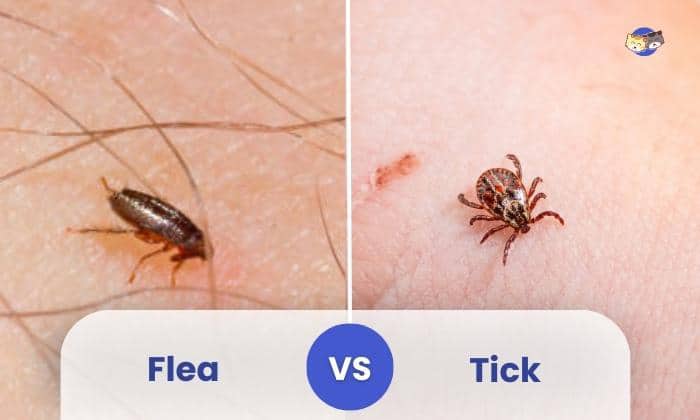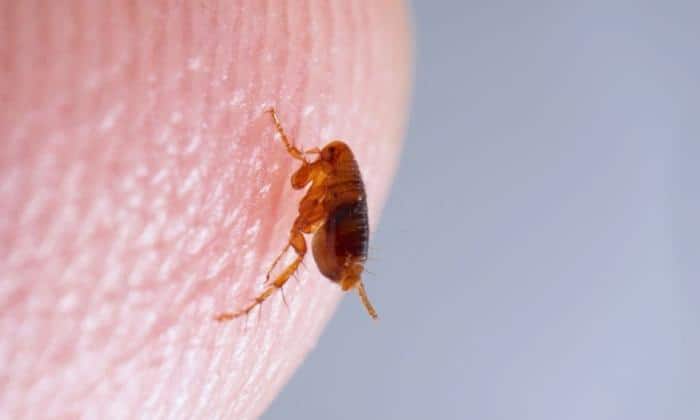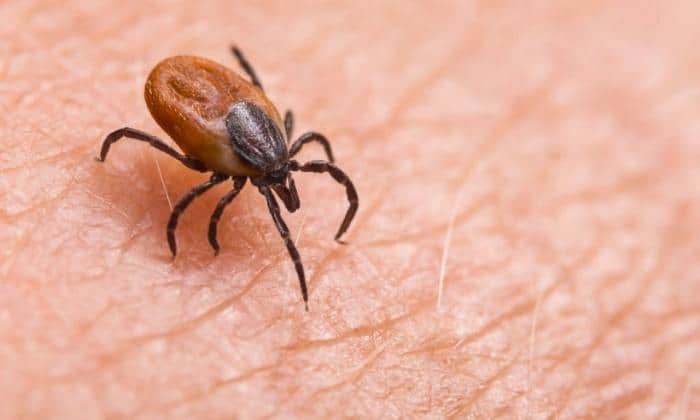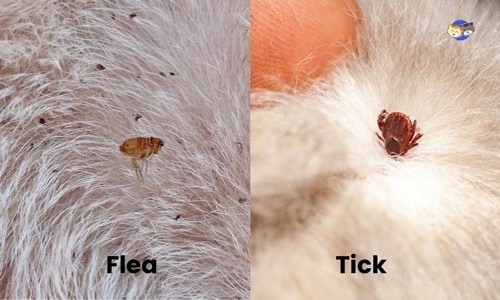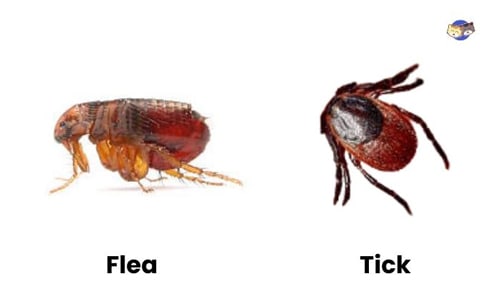As the warm weather approaches, there are usually two parasites that make house pets and their caretakers suffer – fleas and ticks. These tiny insects are notorious for giving pets irritating rashes from their bites.
While fleas and ticks have the same effects on your furry friend, they are completely different parasites. Knowing the difference between them allows you to administer the right medication to your pet.
But what are the differences between fleas vs. ticks?
Table of Contents
What Exactly is a Flea?
Fleas are tiny, wingless ectoparasites, which means they live outside the host’s body and feed on their blood to survive. Their saliva can cause itching, irritation, and allergic reaction once they bite their hosts. These parasites can also carry diseases, such as bubonic plague or typhus.
These parasites are great jumpers, allowing them to travel from one host to another. They target birds and mammals, particularly the furry ones.
There are four stages in the life cycle of a flea – they start as eggs, turn into larvae, develop into pupae, and molt into adult fleas.
- After a female flea feeds on its host’s blood, it will lay eggs, which hatch into larvae and feed on the organic debris on the host’s fur.
- The larvae then enter the pupal stage. Once the pupa metamorphosis, they emerge into adult fleas. This life cycle allows fleas to multiply quickly in their host’s body.
What Are Ticks?
Like fleas, ticks are ectoparasites. They are common in grassy and wooded areas, where they wait for hosts, such as house pets, to pass by. And fleas can also transmit diseases to pets and humans, such as tick fever, lyme disease, or anaplasmosis.
While ticks look like insects, they are more commonly related to arachnids, such as spiders. Once they spot a host animal, they climb on its body with its four pairs of legs and cling to its skin using its mouth.
In addition, ticks have a more complex life cycle than fleas. They start as eggs and mature into larvae but do not enter the pupal stage. Instead, tick larvae develop into nymphs, which feed on the blood of their host until they become an adult.
Ticks vs Fleas: The Similarities
Although fleas and ticks are completely different parasites, they share a few similarities that are worth noting. Below is a comprehensive flea and tick comparison of similarities:
1. Parasitic Nature
As mentioned, ticks and fleas are ectoparasites. They live on the skin of their hosts and use their mouths to suck blood out of them to keep themselves alive.
Both parasites inject saliva into the bloodstream of their hosts. Their saliva functions as an anticoagulant, thus preventing blood from clotting and making it easy to suck.
2. Seasonal Prevalence
These parasites are more prevalent during warm and humid seasons. If you have furry pets at home, you may have noticed that they usually get fleas or ticks during the summer.
However, this does not mean these parasites cannot thrive in cold conditions, considering that they can survive in borderline-freezing temperatures.
3. Choice of Hosts
Fleas and ticks primarily infest house pets, such as cats and dogs. The reason is that these pets are covered in healthy fur, which allows the parasites to hide themselves as they grow and multiply.
Difference Between Fleas and Ticks
You’re probably wondering how to tell the difference between fleas and ticks. To help you know whether your pet has a tick or flea, below are the differences between the two:
1. Appearance
The first and most obvious difference is what do fleas and ticks look like. You can even easily notice the difference by looking at the fleas and ticks pictures above.
Fleas are small and wingless insects with compressed bodies. These parasites have three sets of legs, with the hind ones specialized for jumping. They are typically brown or reddish-brown.
Meanwhile, ticks are arachnids with eight legs and distinct bodies. They are usually larger than fleas, showcasing an oval, flattened body that becomes fat as they suck blood.
2. Size Comparison
Adult fleas are only about 1/8th of an inch. They are so small that most of their features can only be seen through a microscope.
On the other hand, ticks are larger, especially once they have sucked a lot of blood. When a tick is full of blood, it can get to about the size of a grape.
3. Attachment to Hosts
Fleas attach their bodies to hosts by lightly biting the skin’s surface. Meanwhile, ticks burrow their mouths into the host’s skin and anchor themselves firmly to suck blood.
4. Disease Transmission
While fleas and ticks are both disease carriers, the former only carry a few diseases. Instead, they usually cause discomfort and irritation to their hosts.
On the other hand, ticks can transfer severe diseases to animals and humans, such as Rocky Mountain spotted fever and anaplasmosis.
Related: What’s the Difference Between Cat Fleas vs Dog Fleas?
Preventing a Flea and Tick Infestation
Preventing parasites is crucial for the health of your pets. Here are some of the most effective ways to prevent fleas and ticks from living on your furry friend’s body:
- Regular Grooming. Bathing your pet regularly is essential to keeping fleas and ticks away. Grooming is especially important if your pet has long hair.
- Use Parasite Preventatives. Ask your veterinarian what the recommended parasite preventative for your pet is. These preventatives may come in various forms, such as shampoos, collars, and topical treatments
- Maintain A Clean Outdoor Environment. If you bring your pet outside, make sure to keep grass, bushes, and weeds trimmed. As mentioned, ticks can live in grassy areas, so trimming your lawn will reduce the likelihood of these parasites clinging to vegetation.
Flea and Tick Treatment
In an instance that your pet has already been infested, proper flea control and tick removal are vital.
- The best way to treat tick and flea infestation is to bring your pet to a veterinarian. This way, the vet can examine the severity of the infestation, allowing them to recommend and administer proper treatment.
- If the infestation is still mild, your pet’s vet will prescribe topical treatments to kill the fleas and ticks while treating skin irritation.
- Meanwhile, severe cases may require oral medications. These medications, when ingested by your pet, reach their bloodstream.
- But if the parasite infestation is still in its early stage, you can try over-the-counter shampoos and conditioners. These treatments work by killing young and adult fleas, preventing them from multiplying further.
Conclusion
Ticks and fleas may be small, but they can pose a serious danger to your pets. For this reason, it is important to maintain a clean environment.
If you are looking for preventative measures against fleas and ticks, consulting a veterinarian is important. The reason is that each prevention of fleas vss ticks regimen works differently, depending on your pet’s age, health status, and lifestyle, among other factors.

I pursued veterinary studies at the University of Kansas. After several years of practice, I established a veterinary clinic in Kansas. When Michael extended an invitation with a vision that went beyond emergency support – sharing of caregiving information for guardians to create the best living environment for cats, I didn’t hesitate to join the organization.
My role here involves verifying the information presented on the official website. With my experience, I believe the information provided is entirely accurate. If you have any concerns, please feel free to reach out to me


